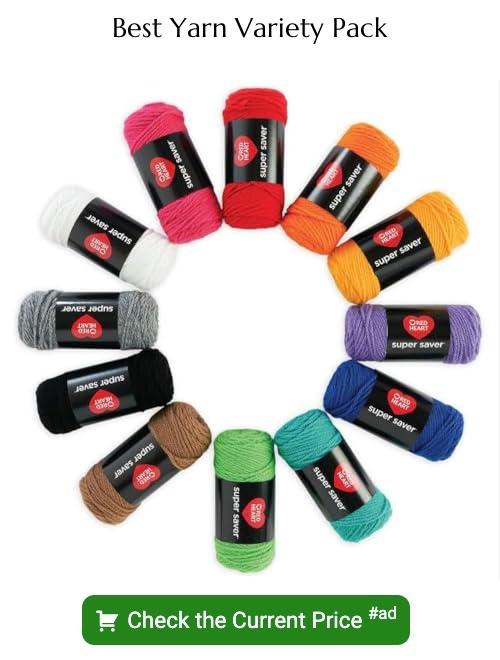Discover the fascinating world of textiles as we unravel the various types of yarn that bring life to your favorite fabrics and designs.
If you’re a yarn enthusiast, you know that the type of yarn you use can make all the difference in your final project. From soft and fluffy to sturdy and durable, there are countless types of yarn available in the textile world.
But with so many options to choose from, it can be overwhelming to know where to start. In this blog post, we’ll explore some of the most popular types of yarn and their unique characteristics.
Whether you’re a seasoned crafter or just starting out, this guide will help you choose the perfect yarn for your next project!
Single Yarns
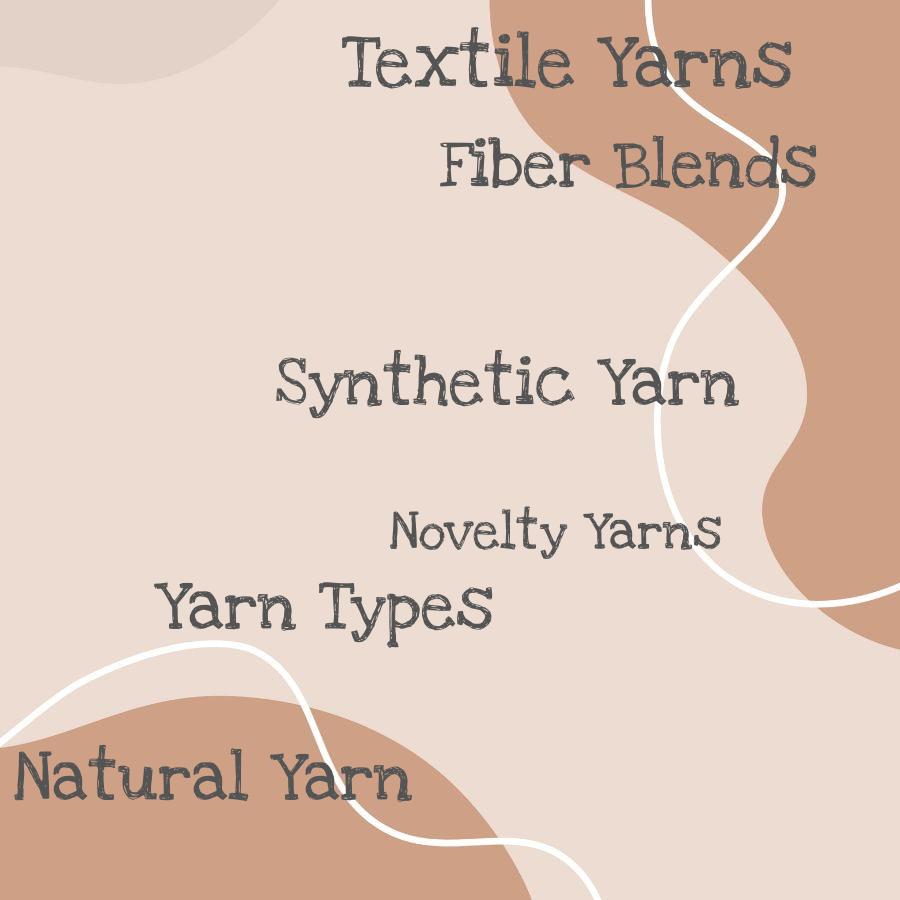
They can be made from various fibers, including wool, cotton, silk or synthetic materials like acrylic or nylon. Single yarns are often used for lightweight fabrics such as summer tops and shawls because they create a delicate drape.
One advantage of using single yarn is that it allows you to showcase the beauty of your stitches without any distractions from other strands. However, since there’s only one strand holding everything together in this type of yarn construction method, it may not be as strong as other types.
When working with single ply yarns in crochet or knitting projects that require durability (such as socks), consider blending them with another fiber to increase their strength and longevity.
Ply Yarns
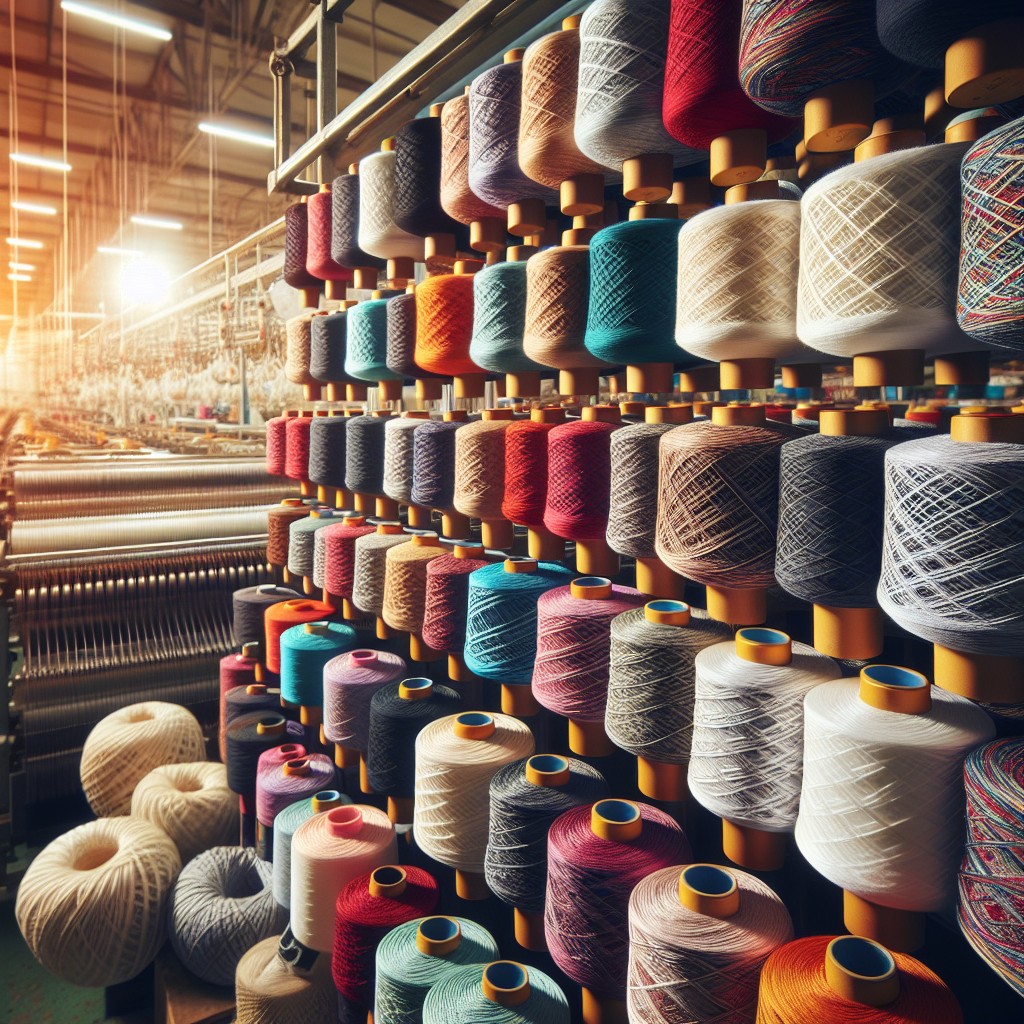
The resulting ply yarn is stronger and more durable than a single strand of the same thickness. Ply yarn can be used for a variety of projects, from blankets to sweaters to scarves.
The number of plies in a ply yarn affects its weight and texture. For example, 2-ply is lighter than 4-ply but has less texture.
On the other hand, 4-ply has more texture but is heavier.
When choosing a ply yarn for your project, consider how much wear and tear it will endure over time. A higher number of plies generally means greater durability.
Some popular types of ply yard include:.
- Two-Ply Yarn: This type consists of two strands twisted together.
- Three-Ply Yarn: This type consists three strands twisted together.
- Four-Ply Yarn: This type consists four strands twisted together.
- In conclusion, if you’re looking for strength and durability in your next project’s fabric or design then consider using one or multiple types/numbers (plies)of this versatile material -ply-yarn!
Cord Yarns
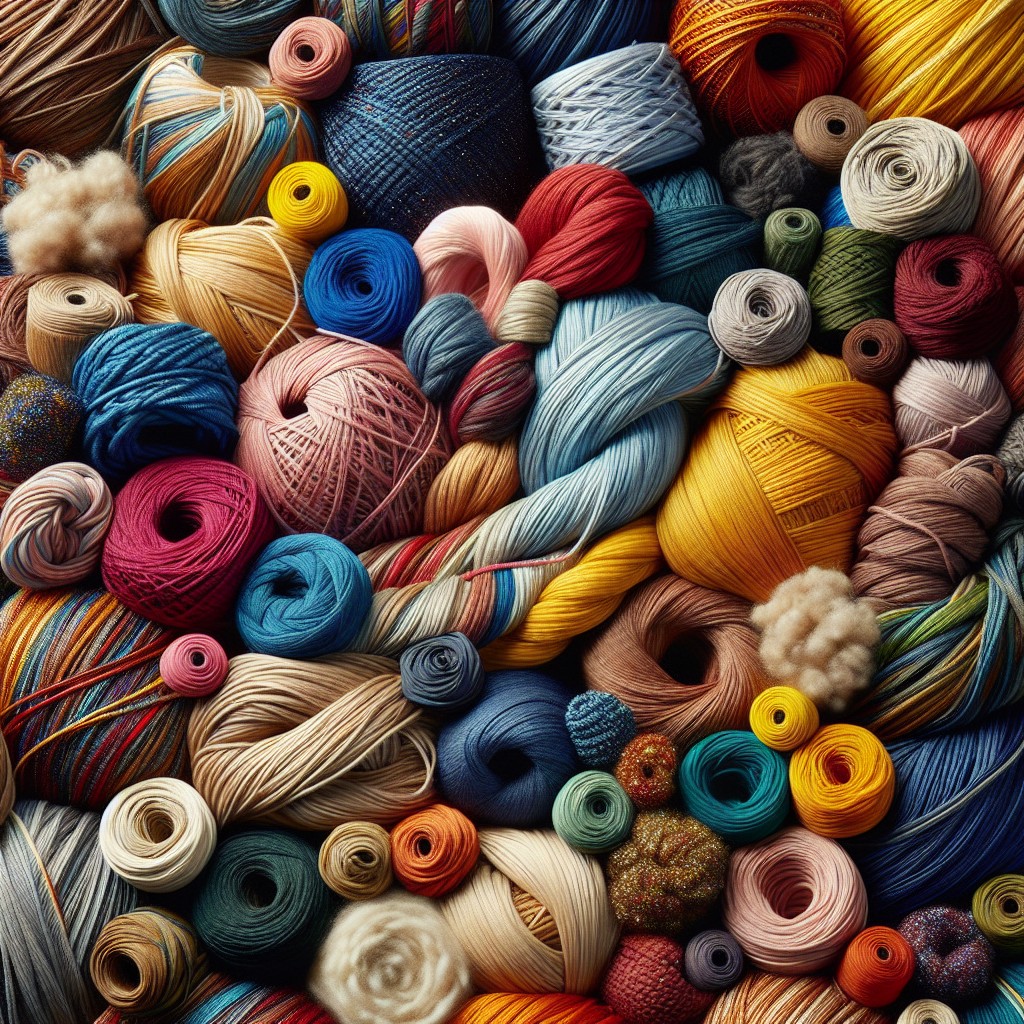
The resulting cord is thicker and stronger than the individual plies, making it ideal for projects that require durability, such as bags or rugs. Cord yarns can be made from a variety of fibers, including wool, cotton, and synthetic materials.
One popular type of cord yarn is macrame cord. This thick cotton rope has a natural look and feel that makes it perfect for creating bohemian-inspired wall hangings or plant hangers.
Another type of cord yarn is jute twine. Made from the fibers of the jute plant, this sturdy material adds an earthy touch to any project.
When working with cord yarns in your projects, keep in mind that they may require larger needles or hooks than other types of yarn due to their thickness. Because they are often used for heavy-duty items like bags or rugs where weight distribution matters most; you should consider using them sparingly if you’re looking to create lightweight garments like scarves and shawls.
Novelty Yarns
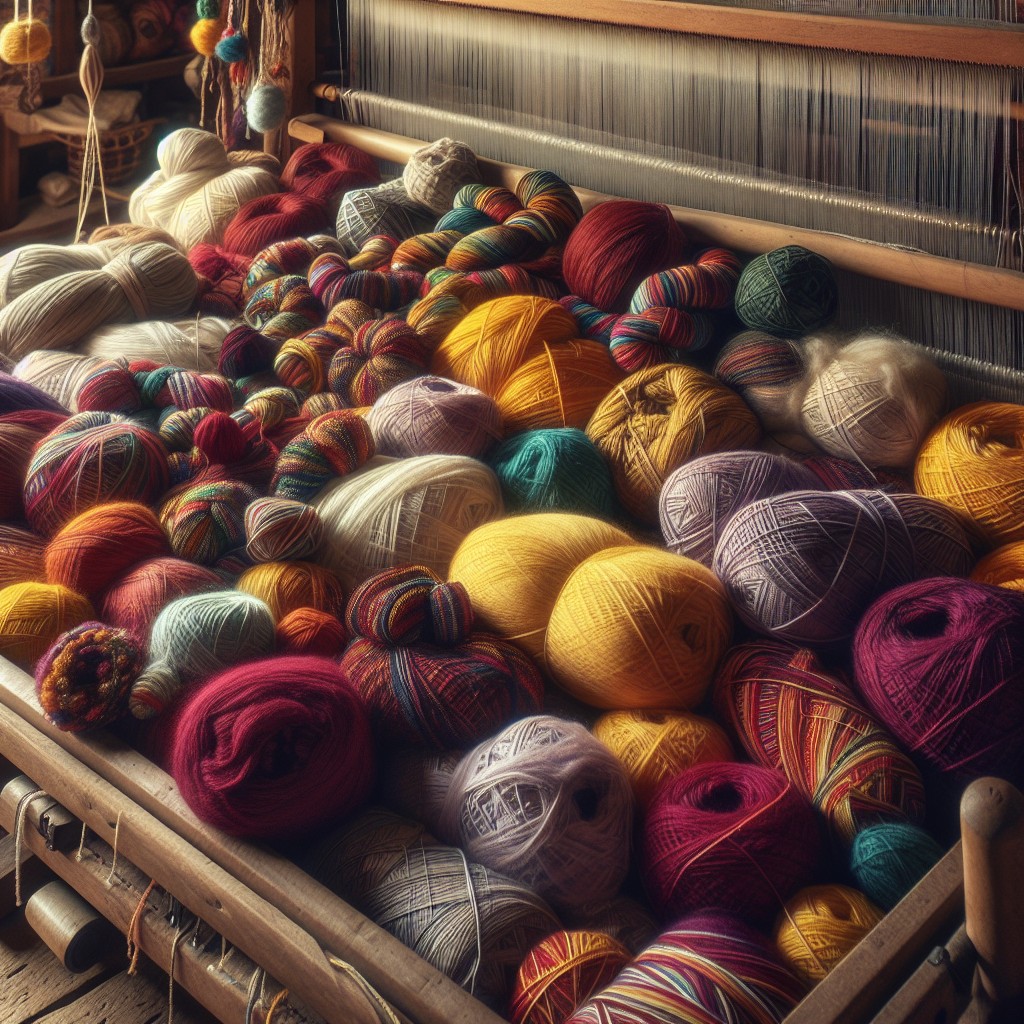
These types of yarns come in a variety of styles, from fluffy boucle to ribbon-like ladder yarn. They can be made from natural or synthetic fibers, or even incorporate materials like beads or sequins for added sparkle.
One popular type of novelty yarn is eyelash yarn, which features long strands that resemble eyelashes. This type of yarn is often used as an accent in scarves and hats for a playful touch.
Another unique option is ribbon or ladder-style novelty yarns that create open spaces between the stitches when knitted up. These types of textures can add dimensionality to your project while still being lightweight.
When working with novelty yams it’s important not only consider their unique characteristics but also how they will affect the overall look and feel you’re trying to achieve with your project.
Textured Yarns
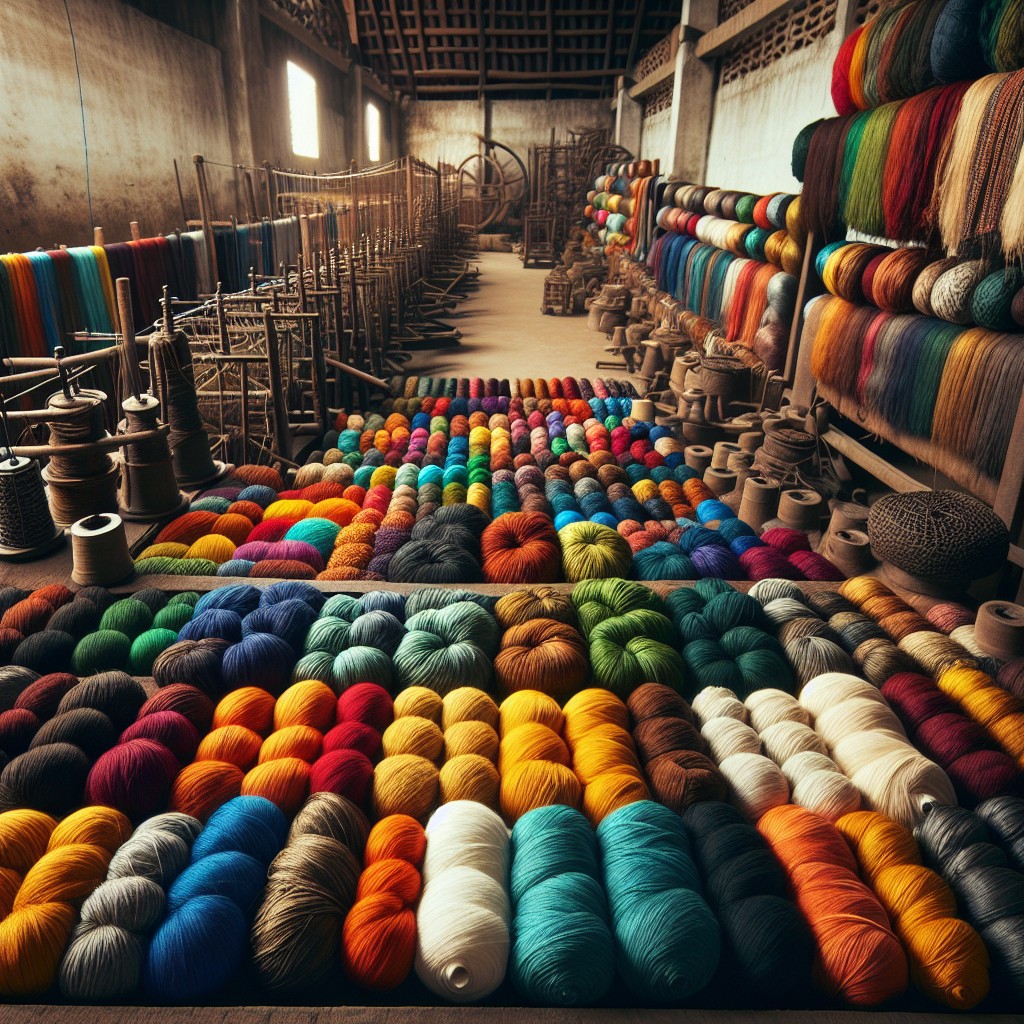
These types of yarns can be made from a variety of fibers, including wool, cotton, acrylic, and more. Textured yarns come in many different forms such as boucle (loops), chenille (velvet-like), ribbon or tape-style strands that create unique textures when knitted or crocheted.
One advantage of using textured yarn is that it can add depth to your work without having to use complicated stitch patterns. The texture created by the unique structure of these types of yarn adds visual appeal and tactile interest.
When working with textured yarns it’s important to keep in mind their thickness as they may affect the gauge you’re aiming for in your project. It’s also essential not only to choose the right type but also consider how much texture you want before starting any project.
Stretch Yarns
These types of yarns are made from synthetic fibers such as spandex or elastane and can stretch up to 500% of their original length without breaking. They’re commonly used in sportswear, swimwear, and other garments that need to fit snugly around the body.
One advantage of using stretch yarn is its ability to retain its shape even after multiple washes. This makes it an ideal choice for clothing items that will be worn frequently or subjected to regular wear and tear.
However, working with stretchy materials can be challenging for beginners as they tend to slip off needles easily while knitting or crocheting. It’s important when working with these types of yarns always use the right needle size recommended by the manufacturer.
Metallic Yarns
These yarns are made by wrapping metallic fibers around a core of natural or synthetic fibers, creating an eye-catching effect that catches the light beautifully. Metallic yarns come in various colors, including gold, silver, copper and bronze.
While they may look delicate and fragile at first glance, metallic yarns can be surprisingly durable when used correctly. They’re perfect for adding accents to scarves or shawls or incorporating into festive holiday decorations like wreaths or ornaments.
When working with metallic yarns it’s important to keep in mind that they can be more challenging than other types of thread due to their slippery texture. It’s best practice not only using sharp needles but also avoiding tight stitches as this could cause the metal strands within the thread from breaking apart.
Natural Yarn Types (Animal and Plant Fibers)
These yarns have been used for centuries to create beautiful textiles that are both durable and comfortable to wear. Animal fibers such as wool, alpaca, cashmere, mohair, angora, llama provide warmth and softness while plant-based fibers like cotton, silk linen bamboo or hemp offer breathability and moisture-wicking properties.
Wool is one of the most popular natural fiber choices for knitting or crocheting due to its versatility in texture and color options. Alpaca is a luxurious alternative with hypoallergenic qualities making it perfect for those with sensitive skin.
Cashmere comes from the undercoat of cashmere goats which makes it incredibly soft but also expensive compared to other natural fiber options like mohair which has a similar texture but at a more affordable price point.
Angora rabbit hair produces fluffy yarn that adds volume without adding weight while Llama wool offers durability combined with excellent insulation properties making it ideal for outdoor garments.
Cotton is another widely used natural fiber known for its breathability in warm weather conditions whereas silk provides luster along with strength when blended into other fabrics. Linen has been around since ancient times providing coolness during hot summers because of its absorbent nature.
Bamboo’s popularity stems from being eco-friendly as well as having anti-bacterial properties useful in baby clothes production. Hemp on the other hand offers durability combined with sustainability features suitable not only clothing items but also home decor products such as rugs or curtains.
Natural Yarn Types (Animal & Plant Fibers) offer unique characteristics depending on their source material; whether you’re looking for warmth & softness (wool), luxury (cashmere), fluffiness(mohair/angora), durability(llama/hemp) ,or eco-friendliness(bamboo/hemp).
Wool
It comes from the fleece of sheep and is known for its warmth, softness, and durability. Wool yarn can be spun into a variety of weights and textures, making it versatile for many different types of projects.
One thing to keep in mind when working with wool yarn is that it can be prone to shrinking or felting if not handled properly. To avoid this issue, always follow care instructions carefully when washing your finished project.
There are also different types of wool available depending on where they come from. Merino wool, for example, comes from a specific breed of sheep known for their fine fleece that’s perfect for next-to-skin wearables like sweaters or scarves.
Alpaca
If you’re looking for a luxurious, soft yarn that’s perfect for cozy winter garments, look no further than alpaca. Alpaca fiber is similar to wool but softer and warmer.
It comes in a range of natural colors from white to black, with shades of brown and gray in between.
One of the benefits of using alpaca yarn is its hypoallergenic properties. Unlike sheep’s wool, which can cause irritation or allergies in some people due to lanolin content, alpacas do not produce this oil on their skin.
Another advantage is its durability; it resists pilling better than other fibers like cashmere or merino wool while still maintaining its shape over time.
Alpacas are native to South America where they have been bred for thousands of years by indigenous communities who use their fleece as clothing material. Today many countries around the world breed them commercially because they are easy animals to care for – requiring little food or water compared with other livestock species – making them an eco-friendly choice too!
Cashmere
It’s known for its softness, warmth, and lightweight feel. Cashmere yarn is highly sought after by knitters and crocheters alike due to its high quality and durability.
One of the benefits of using cashmere yarn in your projects is that it has excellent insulation properties, making it perfect for winter wearables like scarves, hats or sweaters. The fibers are also naturally hypoallergenic which makes them ideal for people with sensitive skin.
However, because cashmere fibers are so fine and delicate they require special care when washing or handling to avoid damage or pilling over time.
Mohair
It’s known for its softness, luster, and durability. Mohair yarn is lightweight and has excellent insulating properties, making it perfect for winter garments like sweaters and scarves.
One of the unique characteristics of mohair yarn is its halo effect – a fuzzy aura that surrounds each strand. This gives finished projects an ethereal quality that can’t be replicated with other fibers.
While mohair may not be as widely used as some other types of yarns due to its higher cost, it’s certainly worth considering if you’re looking to create something truly special. Its strength means your project will last longer than those made with weaker fibers while still maintaining a delicate appearance.
Angora
It’s known for its softness, warmth, and fluffy texture. This luxurious fiber is often blended with other fibers like wool or silk to create unique textures and colors.
One thing to keep in mind when working with angora yarn is that it can shed quite a bit during the knitting or crocheting process. To minimize shedding, try winding your skein into a ball before you start working with it.
Despite its delicate appearance, angora yarn can be surprisingly durable if cared for properly. Hand washing in cool water and laying flat to dry will help maintain the integrity of this beautiful fiber.
Llama
If you’re looking for a soft, warm, and lightweight yarn that’s perfect for winter garments or accessories, llama yarn is an excellent choice. Llamas are native to South America and have been domesticated for thousands of years.
Their wool is prized by knitters and crocheters alike because it’s hypoallergenic, water-resistant, flame-retardant, and naturally insulating.
Llama fiber comes in a range of natural colors from white to black with shades of brown in between. It can be spun into various weights from lace weight to bulky weight depending on the desired project outcome.
One thing to note about llama yarn is that it has little elasticity compared to other animal fibers like wool or alpaca. This means that projects made with 100% llama may stretch out over time if not properly cared for.
Cotton
It’s a soft, breathable material that’s perfect for warm weather clothing and accessories. Cotton yarn can be found in a variety of weights and textures, making it versatile enough to use for everything from dishcloths to sweaters.
One of the benefits of cotton yarn is its absorbency. This makes it an excellent choice for items like washcloths or towels that need to soak up moisture quickly.
Cotton is easy to care for and can be machine washed without fear of shrinking or damage.
When choosing cotton yarn, consider the weight you’ll need based on your project requirements – lighter weights are ideal for summer garments while heavier ones work well with winter wearables such as hats or scarves.
Silk
It’s made from the cocoons of silkworms, which are carefully harvested and processed to create long, smooth fibers that can be spun into yarn. Silk yarn is known for its incredible softness, luster, and drape.
It’s also incredibly strong despite its delicate appearance.
One of the most significant benefits of silk yarn is its breathability – it keeps you cool in hot weather while providing warmth in cold weather. This makes it an excellent choice for garments like scarves or shawls that need to be versatile enough to wear year-round.
Silk comes in various weights ranging from lace weight (the thinnest) up through bulky weight (the thickest). The finer weights are perfect for lightweight garments such as summer tops or delicate lace shawls while heavier weights work well with winter accessories like hats or mittens.
When working with silk yarns, keep in mind they require special care during washing due to their delicacy; hand-washing using mild soap should suffice.
Linen
It’s one of the oldest textiles in human history, dating back to ancient Egypt where it was used for clothing and burial shrouds. Linen has a unique texture that makes it perfect for summer garments because of its breathability and moisture-wicking properties.
One of the benefits of linen yarn is its durability; it can last up to 30 years with proper care! This makes linen an excellent choice for items like tablecloths, napkins, and bedding that will see frequent use.
When working with linen yarns, keep in mind that they tend to be stiffer than other fibers like cotton or wool. However, after washing and wearing them several times, they become softer over time while still maintaining their shape.
If you’re looking for eco-friendly options when choosing your next project’s materials – consider using linen as this fabric requires less water than cotton during production making it more sustainable overall!.
Bamboo
It’s made from the pulp of bamboo grass and is known for being soft, lightweight, and breathable. Bamboo yarn also has moisture-wicking abilities, making it an excellent choice for summer garments or accessories.
One of the benefits of using bamboo yarn is that it’s hypoallergenic and doesn’t irritate sensitive skin like some other fibers can. Bamboo grows quickly without the need for pesticides or fertilizers, making it a sustainable option compared to other plant-based fibers.
When working with bamboo yarns in your projects, keep in mind that they tend to be slippery and may require more tension when knitting or crocheting than traditional wool-based options. However, once you get used to working with this unique fiber type – you’ll love how smooth your stitches look!
Hemp
It’s an eco-friendly option because it requires less water and pesticides than cotton, making it a sustainable choice for those who are environmentally conscious. Hemp yarn is strong and durable, which makes it perfect for creating items like bags, hats, and even clothing.
One of the unique characteristics of hemp yarn is its ability to soften with each wash while still maintaining its strength. This means that your finished project will become more comfortable over time without losing any durability.
Another benefit of using hemp yarn in your projects is its antimicrobial properties. Hemp fibers naturally resist bacteria growth which can help keep your finished item fresh longer between washes.
Synthetic Yarn Types (Man-Made Yarn Fibers)
These fibers are created through chemical processes and can mimic the properties of natural fibers or offer unique characteristics not found in nature.
Acrylic is a popular synthetic fiber that is often used as a substitute for wool due to its softness and warmth. It’s also lightweight, easy to care for, and comes in a wide range of colors.
Polyester is another common synthetic fiber that’s known for its durability and resistance to wrinkles, shrinking, fading, and mildew. It’s often blended with other fibers like cotton or wool to improve their strength.
Rayon is made from wood pulp treated with chemicals that dissolve it into a viscous liquid before being spun into threads. This process gives rayon the look and feel of silk but at an affordable price point.
Nylon was first developed as an alternative material during World War II when silk became scarce. Today it’s commonly used in activewear due to its moisture-wicking properties but can be blended with other materials like wool or cotton too.
Acrylic
It’s made from synthetic fibers that are easy to care for and come in a wide range of colors. Acrylic yarn is perfect for creating blankets, scarves, hats, and other items that require frequent washing or exposure to the elements.
One of the benefits of acrylic yarn is its resistance to fading and shrinking. Unlike natural fibers like wool or cotton which can shrink when exposed to heat or moisture during washing; acrylic retains its shape even after multiple washes.
Another advantage of using acrylic yarn is that it’s hypoallergenic making it an excellent option if you have sensitive skin or allergies. This type of fiber dries quickly compared with natural fibers such as wool which take longer time drying out completely.
Polyester
It’s made from petroleum-based products and is known for its durability, wrinkle resistance, and ability to hold color well. Polyester yarns are often used in clothing items such as jackets, pants, and dresses because of their strength and resistance to wear-and-tear.
One of the benefits of polyester yarns is that they’re easy to care for – they can be machine washed without shrinking or losing their shape. They’re also quick-drying which makes them ideal for outdoor activities like hiking or camping.
However, some people may find polyester uncomfortable due to its lack of breathability compared with natural fibers like cotton or wool. It’s not an eco-friendly option since it’s derived from non-renewable resources.
Rayon
It was first developed as an alternative to silk and quickly became a favorite among textile manufacturers due to its versatility and affordability. Rayon is made from cellulose fibers derived from wood pulp, making it a semi-synthetic fiber.
One of the benefits of rayon yarn is its softness, which makes it ideal for creating comfortable clothing items such as dresses, blouses, and skirts. It also drapes beautifully when used in home decor projects like curtains or tablecloths.
Another advantage of rayon yarn is that it can be easily dyed into vibrant colors without losing its luster or sheen. This makes it perfect for adding pops of color to your knitting or crocheting projects.
However, one thing to keep in mind when working with rayon yarns is their tendency to shrink if not handled properly during washing and drying. To avoid this issue, always follow the care instructions on the label carefully.
Nylon
It quickly became popular due to its durability, strength, and resistance to abrasion. Nylon yarn is made from petroleum-based chemicals that are melted down and then extruded through small holes called spinnerets.
The resulting fibers are then spun into yarn.
One of the benefits of nylon yarn is its versatility – it can be used for a wide range of projects including clothing, accessories, and home decor items like rugs or curtains. Nylon also has excellent elasticity which makes it ideal for use in stretchy fabrics like athletic wear or swimwear.
Another advantage of nylon is its ability to hold color well without fading over time – this means your finished project will look vibrant even after multiple washes! However, one downside to using nylon as a knitting or crochet material is that it can be quite slippery on needles/hooks making it difficult for beginners.
Yarn Fiber Blends
These types of yarns are made by combining two or more different fibers to create a unique blend with enhanced properties. For example, blending wool and silk creates a luxurious and soft texture while adding nylon can increase durability.
Fiber blends offer endless possibilities for creativity in knitting or crocheting projects. They allow you to experiment with different textures, colors, and weights to achieve the desired effect in your final product.
Some popular fiber blends include cotton-polyester blend (for added strength), wool-acrylic blend (for warmth without itchiness), bamboo-cotton-silk blend (for softness and drape) among others.
When choosing a fiber-blend yarn type for your project consider factors such as weight category, texture preference as well as care instructions since each type may have its own washing requirements due to varying compositions of fibers used. .
Whether you prefer natural animal/plant-based fibers like wool or synthetic man-made ones like acrylic; there is always something new to learn about types of yarn available in textile crafting world.
Novelty and Specialty Yarn Types
These yarns come in a variety of textures, colors, and fibers that can make any project stand out. Some popular novelty yarn types include boucle, chenille, eyelash yarns (also known as fun fur), ribbon or tape yarns, ladder or trellis-style ribbon yarns.
Boucle is a textured novelty type of wool that has loops throughout the strand giving it an interesting texture when knitted up. Chenille is another soft-textured fiber with short pile-like strands sticking out from the core thread which gives it its velvety feel.
Eyelash Yarn adds fluffy accents to your knitting projects; this type of specialty fiber creates long tufts along the length of each strand resembling eyelashes! Ribbon or Tape Yarn comes in flat strips rather than round threads making them perfect for creating unique designs like ruffles on scarves.
Ladder/Trellis-Style Ribbon Yarn features small holes running down their center which makes them ideal for lacy patterns such as shawls.
How to Choose a Yarn Type for Your Project
First and foremost, you’ll want to think about what type of item you’re making. Is it a cozy sweater or a delicate lace shawl? The weight and texture of the yarn will play an important role in how your finished piece looks and feels.
Next, consider who will be wearing or using the item. If it’s for someone with sensitive skin or allergies, natural fibers like cotton or silk may be best.
On the other hand, if durability is key (think socks!), synthetic blends like acrylics can hold up well over time.
Another factor to keep in mind is color choice – some types of yarn take dye better than others which can affect how vibrant your colors turn out.
Don’t forget about gauge! Make sure that whatever type of yarn you choose matches up with your pattern’s recommended gauge so that everything fits together perfectly.
Yarn Type Comparison Chart
A yarn type comparison chart allows you to see at a glance the different characteristics of each type of yarn, including fiber content, weight category, and recommended needle or hook size. This makes it easier to choose the perfect yarn for your project based on its intended use and desired outcome.
For example, if you’re looking for a soft and cozy blanket that will keep you warm during chilly nights in winter months then wool or alpaca would be great choices as they are both known for their warmth retention properties. On the other hand if you want something lightweight with good drape like summer tops then cotton or bamboo might work better.
A comparison chart also helps when substituting one type of yarn with another in patterns where gauge is important because not all types have similar thicknesses even within same weight categories.
What’s the Best Knitting Yarn for Allergies and Sensitive Skin?
Certain fibers may cause itching, redness, or other allergic reactions. Fortunately, there are many hypoallergenic options available that are gentle on even the most sensitive skin.
One of the best knitting yarns for allergies and sensitive skin is bamboo yarn. This type of yarn is made from bamboo grass and has a soft texture similar to silk or cashmere.
It’s also naturally antibacterial and moisture-wicking which makes it an excellent choice for summer garments.
Another great option is cotton yarn which comes in a variety of weights suitable for different projects such as dishcloths, baby blankets among others. Cotton fibers have no lanolin (a common allergen) making them ideal for people with wool sensitivities.
If you’re looking to avoid animal-based products altogether then acrylic might be your go-to option since it’s synthetic but still very soft like natural fiber types mentioned above. When shopping around look out specifically labeled “hypoallergenic” on packaging labels as they indicate that these types have been tested by manufacturers to ensure they don’t contain any irritants known to trigger allergic reactions.
What’s the Best Yarn Type for Beginners?
With so many options available, it’s easy to get overwhelmed and end up with a project that doesn’t turn out quite as planned. But fear not! There are some types of yarn that are perfect for beginners.
Acrylic is one such type of yarn that is great for those just starting out. It’s affordable, widely available in craft stores and online shops, and comes in an array of colors.
Acrylic also has the added benefit of being machine washable which makes it ideal for projects like baby blankets or scarves.
Another beginner-friendly option is cotton yarn which is soft yet durable making it perfect for dishcloths or summer garments like tank tops or beach cover-ups.
When selecting your first few skeins (a length unit used by knitters), consider sticking with solid colors rather than variegated ones as they can be more challenging to work with until you have gained some experience working with different textures and patterns.
Types of Yarn: Printable Summary
That’s why we’ve created a printable summary that you can use as a reference guide for your next project. This handy chart lists the most popular types of yarn and their unique characteristics, including natural fibers like wool and cotton, synthetic fibers like acrylic and polyester, novelty yarns with fun textures or metallic accents, and more.
Print out this chart to help you choose the perfect type of yarn for your next knitting or crochet project. Keep it in your crafting space as a quick reference guide whenever you need inspiration or guidance on which type of fiber will work best for your design.
Remember that choosing the right type of yarn is essential not only for achieving the desired look but also ensuring durability over time.
Yarn Weight Categories & Conversion Explained
Yarn weight refers to the thickness of the yarn and can range from super fine (also known as lace) all the way up to jumbo. Each weight category has its own unique characteristics that make it suitable for different types of projects.
To help you navigate through this world of weights, we’ve put together a handy chart that outlines each category and its corresponding hook or needle size. This chart will also come in handy when converting patterns from one country’s standard measurement system into another’s.
It’s worth noting that not all brands follow these standards exactly, so be sure to check your label before starting a new project! With this knowledge at hand, you’ll be able to confidently choose the perfect yarn weight for any project on your list.
Yarn Textures and Why They Matter
The texture of the yarn can affect the overall look and feel of your finished product, as well as its durability and functionality. Some popular yarn textures include smooth, fluffy, bumpy, slubby (irregular thickness), boucle (loops), chenille (velvet-like) and ribbon.
Smooth textured yarns are perfect for creating clean lines in a pattern or stitch work while fluffy textured ones add volume to your projects like scarves or hats. Bumpy textured yarns create a unique surface that adds depth to any design while slubby ones give off an organic vibe with their irregular thicknesses.
Boucle is great for adding interest to simple patterns by introducing loops into the fabric’s structure; it also creates warmth due to its air pockets between each loop. Chenille has a velvety texture that makes it ideal for soft toys such as teddy bears because they have no scratchy fibers on them which could irritate sensitive skin types.
Ribbon-textured yarn is flat but wide making it perfect for weaving through other fabrics like crochet squares or knitted panels giving them added dimensionality without being too bulky.
FAQ
What are the different types of textile yarn?
Answer: The different types of textile yarn are staple fiber yarn, ply yarns, and filament yarn.
What are the categories of yarn?
Answer: The categories of yarn, numbered 0 through 7, are lace (0), super fine (1), fine (2), light (3), medium (4), bulky (5), super bulky (6), and jumbo (7).
What are three different types of yarn?
Three different types of yarn are wool, acrylic, and cotton.
What are the two main types of yarns?
The two main types of yarns are spun yarn and filament yarn.
What are the primary materials used for producing various textile yarns?
Primary materials used for producing textile yarns include natural fibers like cotton, wool, silk, and linen, as well as synthetic fibers like nylon, polyester, and acrylic.
How do the properties of different yarn types affect their applications in textile products?
Different yarn types possess unique properties, such as strength, elasticity, absorbency, warmth, and texture, which influence their applications in textile products.
What is the process of yarn production for different types of fibers?
Yarn production involves various processes such as cleaning, carding, combing, spinning, and plying for different types of fibers, like cotton, wool, and synthetic ones.
